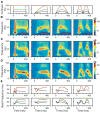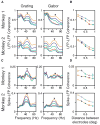Differences in gamma frequencies across visual cortex restrict their possible use in computation
- PMID: 20826318
- PMCID: PMC3001273
- DOI: 10.1016/j.neuron.2010.08.004
Differences in gamma frequencies across visual cortex restrict their possible use in computation
Abstract
Neuronal oscillations in the gamma band (30-80 Hz) have been suggested to play a central role in feature binding or establishing channels for neural communication. For these functions, the gamma rhythm frequency must be consistent across neural assemblies encoding the features of a stimulus. Here we test the dependence of gamma frequency on stimulus contrast in V1 cortex of awake behaving macaques and show that gamma frequency increases monotonically with contrast. Changes in stimulus contrast over time leads to a reliable gamma frequency modulation on a fast timescale. Further, large stimuli whose contrast varies across space generate gamma rhythms at significantly different frequencies in simultaneously recorded neuronal assemblies separated by as little as 400 microm, making the gamma rhythm a poor candidate for binding or communication, at least in V1. Instead, our results suggest that the gamma rhythm arises from local interactions between excitation and inhibition.
2010 Elsevier Inc. All rights reserved.
Figures





Similar articles
-
Robust gamma coherence between macaque V1 and V2 by dynamic frequency matching.Neuron. 2013 May 8;78(3):523-36. doi: 10.1016/j.neuron.2013.03.003. Neuron. 2013. PMID: 23664617
-
Spatial attention in area V4 is mediated by circuits in primary visual cortex.Neural Netw. 2009 Oct;22(8):1039-54. doi: 10.1016/j.neunet.2009.07.010. Epub 2009 Jul 18. Neural Netw. 2009. PMID: 19643574
-
Synchronization dynamics in response to plaid stimuli in monkey V1.Cereb Cortex. 2010 Jul;20(7):1556-73. doi: 10.1093/cercor/bhp218. Epub 2009 Oct 7. Cereb Cortex. 2010. PMID: 19812238 Free PMC article.
-
LFP power spectra in V1 cortex: the graded effect of stimulus contrast.J Neurophysiol. 2005 Jul;94(1):479-90. doi: 10.1152/jn.00919.2004. Epub 2005 Feb 9. J Neurophysiol. 2005. PMID: 15703230
-
Theta coupling between V4 and prefrontal cortex predicts visual short-term memory performance.Nat Neurosci. 2012 Jan 29;15(3):456-62, S1-2. doi: 10.1038/nn.3038. Nat Neurosci. 2012. PMID: 22286175
Cited by
-
Learning probability distributions of sensory inputs with Monte Carlo predictive coding.PLoS Comput Biol. 2024 Oct 30;20(10):e1012532. doi: 10.1371/journal.pcbi.1012532. eCollection 2024 Oct. PLoS Comput Biol. 2024. PMID: 39475902 Free PMC article.
-
Strength of gamma rhythm depends on normalization.PLoS Biol. 2013;11(2):e1001477. doi: 10.1371/journal.pbio.1001477. Epub 2013 Feb 5. PLoS Biol. 2013. PMID: 23393427 Free PMC article.
-
High-frequency neural activity and human cognition: past, present and possible future of intracranial EEG research.Prog Neurobiol. 2012 Sep;98(3):279-301. doi: 10.1016/j.pneurobio.2012.06.008. Epub 2012 Jun 26. Prog Neurobiol. 2012. PMID: 22750156 Free PMC article. Review.
-
Functionally Distinct Gamma Range Activity Revealed by Stimulus Tuning in Human Visual Cortex.Curr Biol. 2019 Oct 21;29(20):3345-3358.e7. doi: 10.1016/j.cub.2019.08.004. Epub 2019 Oct 3. Curr Biol. 2019. PMID: 31588003 Free PMC article.
-
Spontaneous Spiking Is Governed by Broadband Fluctuations.J Neurosci. 2022 Jun 29;42(26):5159-5172. doi: 10.1523/JNEUROSCI.1899-21.2022. Epub 2022 May 23. J Neurosci. 2022. PMID: 35606140 Free PMC article.
References
-
- Bartos M, Vida I, Jonas P. Synaptic mechanisms of synchronized gamma oscillations in inhibitory interneuron networks. Nat Rev Neurosci. 2007;8:45–56. - PubMed
-
- Berens P, Velasco MJ. MPI Technical Report No 184. 2009.
-
- Brunel N, Wang XJ. What determines the frequency of fast network oscillations with irregular neural discharges? I. Synaptic dynamics and excitation-inhibition balance. J Neurophysiol. 2003;90:415–430. - PubMed
Publication types
MeSH terms
Grants and funding
LinkOut - more resources
Full Text Sources
Other Literature Sources

